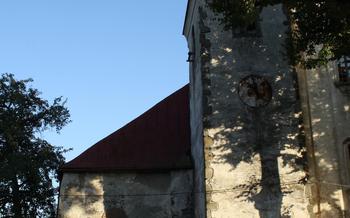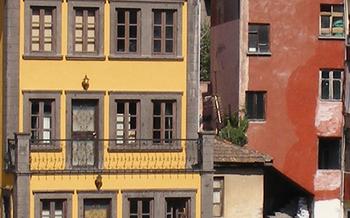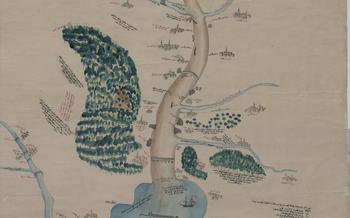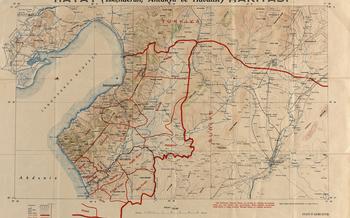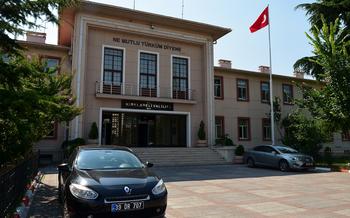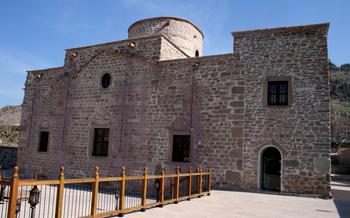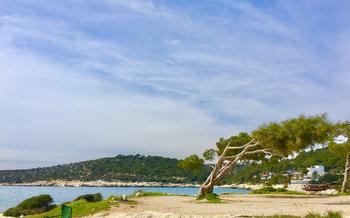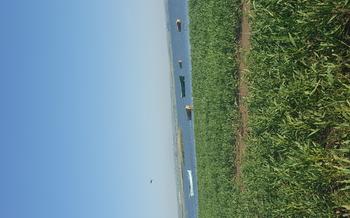
Papazlık Monastery
- The Papazlık Monastery: A Hidden Gem in Kırklareli
- Location and Accessibility
- Exploring the Monastery Grounds
- Historical Significance
- Legends and Folklore
- Restoration Efforts
- Visitor Facilities
- Unveiling the Frescoes
- Exploring the Villages Nearby
- Nature's Embrace
- Pilgrimage and Spirituality
- Local Handicrafts
- Gastronomic Delights
- Festivals and Celebrations
- Insider Tip: Hidden Paths
The Papazlık Monastery: A Hidden Gem in Kırklareli
The Papazlık Monastery, nestled in the verdant hills of Kırklareli, stands as a testament to the region's rich history and religious heritage. Its origins can be traced back to the 10th century when it was established as a humble retreat for Orthodox monks seeking solace and spiritual enlightenment. Over the centuries, the monastery grew in prominence, becoming a center of religious learning and pilgrimage. Its architectural features, blending Byzantine and Ottoman influences, reflect the diverse cultural heritage of the region. The monastery's intricate frescoes, vibrant with color and symbolism, depict biblical scenes and saints, adding to its spiritual significance. Despite the passage of time and the challenges it has faced, the Papazlık Monastery remains a sacred site, attracting visitors from near and far who seek to connect with its enduring spiritual essence.
Location and Accessibility
The Papazlık Monastery is nestled in the picturesque village of Kırklareli, situated in the Marmara region of Turkey. This hidden gem lies approximately 130 kilometers west of Istanbul, the country's vibrant metropolis. Visitors can conveniently reach the monastery by car, taking the scenic route through the charming countryside. The journey from Istanbul takes about two hours, offering a delightful opportunity to admire the region's natural beauty.
For those without their own transportation, public transportation options are available. Regular bus services operate from Istanbul's main bus terminals, providing a comfortable and affordable way to reach Kırklareli. Upon arrival in the village, visitors can either walk or take a short taxi ride to the monastery, which is located just a few kilometers away.
Once you arrive at the monastery, you will be greeted by a sense of tranquility and awe. The serene atmosphere, coupled with the stunning views of the surrounding landscape, creates an ideal setting for exploration and reflection.
Exploring the Monastery Grounds
The Papazlık Monastery is a captivating complex that invites visitors to delve into its rich history and architectural marvels. As you step through its gates, you'll be greeted by a serene courtyard, surrounded by imposing stone structures that speak of a bygone era.
The main church, the heart of the monastery, stands tall with its elegant dome and intricate frescoes adorning its interior. Inside, you'll find a sanctuary adorned with beautiful artwork, evoking a sense of spirituality and awe.
Other notable buildings within the complex include the refectory, where monks once gathered for meals, and the scriptorium, where they meticulously copied religious texts. These spaces, though worn by time, still exude an aura of reverence and tranquility.
As you wander through the monastery grounds, take note of the architectural details that make this site unique. From the graceful arches and vaulted ceilings to the intricate carvings and inscriptions, each element contributes to the overall splendor of the monastery.
Historical Significance
The Papazlık Monastery holds immense historical significance as a testament to the region's rich religious and cultural heritage. Built during the Byzantine era, the monastery has witnessed centuries of religious devotion, political upheavals, and cultural exchanges. It served as a spiritual center for the local Christian community and played a crucial role in spreading Christianity throughout the region.
The monastery's architecture reflects the influence of various cultures and periods, showcasing elements of Byzantine, Ottoman, and modern architectural styles. Its well-preserved frescoes and iconography provide valuable insights into the artistic and religious traditions of the past. The monastery's history is intertwined with the stories of monks, pilgrims, and local inhabitants, each contributing to its unique identity and significance.
Today, the Papazlık Monastery stands as a reminder of the region's diverse religious history and serves as a poignant symbol of the enduring power of faith and spirituality. It continues to attract visitors from near and far who come to explore its historical significance, admire its architectural beauty, and seek spiritual inspiration.
Legends and Folklore
The Papazlık Monastery, steeped in history and religious significance, has woven itself into the fabric of local legends and folklore. One popular tale tells of a young shepherd boy who stumbled upon a hidden cave beneath the monastery. Inside, he discovered a secret chamber adorned with shimmering treasures and guarded by a benevolent spirit. Word of his miraculous find spread throughout the region, attracting pilgrims and fortune seekers alike.
Another legend speaks of a monk who possessed the gift of healing. With a gentle touch and a prayer, he could cure the sick and mend broken bones. People from far and wide sought his miraculous touch, and the monastery became a sanctuary for the suffering.
A third tale recounts the appearance of a mysterious woman dressed in white who would emerge from the monastery's depths on moonlit nights. Some believed she was the ghost of a former nun who had taken her own life within the monastery walls. Others claimed she was a celestial being, a guardian of the sacred grounds.
Restoration Efforts
At present, the Papazlık Monastery is undergoing a comprehensive restoration project aimed at preserving its historical significance and architectural beauty. The project, initiated by the Turkish Ministry of Culture and Tourism, involves a team of experts dedicated to restoring the monastery to its former glory.
One of the key challenges lies in the monastery's structural integrity. Exposure to the elements and neglect over the years have resulted in damaged walls, weakened foundations, and deteriorated roofs. The restoration team meticulously assesses each section of the complex, reinforcing structures, repairing stonework, and replacing damaged elements with authentic materials.
Another aspect of the restoration process focuses on the monastery's artistic heritage. The vibrant frescoes that adorn the interior walls have suffered from fading colors, peeling paint, and environmental damage. Skilled conservators employ specialized techniques to clean, stabilize, and restore the frescoes, ensuring their preservation for future generations.
The restoration efforts not only aim to restore the physical structure but also to revive the monastery's spiritual and cultural significance. By breathing new life into this historical gem, the project seeks to transform the Papazlık Monastery into a vibrant center for religious observance, cultural exchange, and tourism.
Visitor Facilities
At the Papazlık Monastery, visitors can immerse themselves in the history and spirituality of the site through guided tours. These tours provide in-depth insights into the monastery's past, its architectural features, and its religious significance. Knowledgeable guides lead visitors through the complex, sharing stories and anecdotes that bring the monastery's history to life.
For those who prefer to explore at their own pace, a visitor center offers informative brochures and maps. The center also serves as a hub for information on the surrounding region, including details on nearby attractions, transportation options, and local customs.
The monastery grounds are equipped with essential amenities to ensure a comfortable visit for all. Clean and well-maintained restrooms are available for the convenience of visitors. Additionally, a designated parking area provides ample space for vehicles, allowing visitors to park conveniently and safely.
By providing these visitor facilities, the Papazlık Monastery strives to create a welcoming and informative environment for all those who come to explore its rich history and spiritual significance.
Unveiling the Frescoes
In a remarkable turn of events, the Papazlık Monastery revealed a hidden treasure that captivated the attention of art historians and enthusiasts worldwide. Beneath layers of plaster, a series of stunning frescoes emerged, portraying biblical scenes, angelic figures, and intricate patterns. These awe-inspiring artworks, believed to date back to the 14th century, offer a glimpse into the monastery's rich artistic heritage and provide valuable insights into the religious and cultural traditions of the region.
The discovery of the frescoes was a serendipitous accident during restoration work in the 1950s. As workers carefully removed layers of plaster from the walls, vibrant colors and intricate details began to appear, revealing a hidden masterpiece that had been concealed for centuries. The frescoes, executed with remarkable skill and artistry, depict a variety of religious themes, including the life of Christ, the Virgin Mary, and various saints.
The artistic significance of the frescoes lies in their unique blend of Byzantine and local influences. The iconography and style of the paintings reflect the strong Byzantine artistic tradition that prevailed in the region during the Middle Ages. However, the frescoes also incorporate elements of local culture and traditions, creating a distinctive and harmonious artistic expression.
The restoration and preservation of the frescoes pose significant challenges due to their age and the delicate nature of the materials used. Experts have meticulously undertaken the task of conserving and restoring these priceless artworks, employing specialized techniques to stabilize and protect the pigments and surfaces. The ongoing efforts aim to ensure that these magnificent frescoes can continue to inspire and captivate visitors for generations to come.
Exploring the Villages Nearby
Beyond the monastery's walls, the surrounding villages offer a glimpse into the region's rich cultural heritage and traditional way of life. Nestled amidst rolling hills and lush greenery, these charming villages exude a timeless aura, inviting visitors to immerse themselves in local customs and hospitality.
A Journey into Tradition
A stroll through the narrow cobblestone streets reveals traditional houses adorned with intricate wood carvings and colorful window frames. Villagers go about their daily lives, tending to their fields, weaving intricate textiles, or crafting handmade pottery using techniques passed down through generations. The air is filled with the sounds of laughter, the aroma of freshly baked bread, and the rhythmic clinking of hammers against copper in the village's blacksmith shop.
Encounters with the Locals
The villagers are renowned for their warm hospitality and take pride in sharing their culture with visitors. Engage in lively conversations over a cup of Turkish coffee, savor traditional dishes prepared with local ingredients, and learn about the village's history and customs from the elders. Don't be surprised if you're invited to join in on a traditional dance or music performance, as the villagers love to celebrate life and share their joy with others.
Authentic Experiences
For those seeking a truly immersive experience, consider staying in one of the village guesthouses, where you'll be welcomed as part of the family. Participate in daily activities, learn traditional crafts, and savor homemade meals prepared with love and fresh ingredients. Whether you're baking bread in a communal oven, weaving colorful rugs, or tending to the village's organic garden, you'll gain a deep appreciation for the region's rural lifestyle.
Discover Hidden Gems
Venture beyond the main village square to discover hidden gems that offer a glimpse into the region's past. Explore ancient ruins, visit local churches and mosques, or simply wander through the winding streets, allowing yourself to get lost in the village's tranquil atmosphere. With every step, you'll uncover new stories and make memories that will last a lifetime.
Nature's Embrace
The Papazlık Monastery is nestled amidst the picturesque landscapes of Kırklareli, inviting nature enthusiasts to explore its surroundings. Scenic walking trails wind through lush forests, offering panoramic views of the region. Birdwatching enthusiasts can spot a variety of species fluttering among the trees, and wildlife enthusiasts may catch a glimpse of local creatures in their natural habitat. The monastery's serene setting provides a tranquil ambiance for hiking, nature walks, and relaxation in the heart of Turkey's natural beauty.
Pilgrimage and Spirituality
The Papazlık Monastery holds deep religious significance as a revered pilgrimage site for Christians from near and far. Throughout history, believers have undertaken pilgrimages to this sacred place, seeking spiritual enlightenment and connection with the divine. The monastery's serene atmosphere and its association with religious figures and events have made it a popular destination for spiritual seekers.
Annually, the monastery welcomes numerous pilgrims who come to pay homage, offer prayers, and participate in religious ceremonies. These ceremonies often involve traditional rituals, such as candle lighting, incense burning, and chanting of prayers. Pilgrims often seek blessings, pray for guidance, and give thanks for answered prayers.
In addition to pilgrimages, the monastery also hosts spiritual retreats and meditation sessions, providing an opportunity for individuals to deepen their spiritual connection and find inner peace. These retreats often include guided meditations, yoga classes, and discussions on spiritual topics. The monastery's tranquil setting and its rich history create a conducive environment for spiritual reflection and self-discovery.
Local Handicrafts
The region surrounding the Papazlık Monastery is renowned for its vibrant tradition of handicrafts. Visitors can immerse themselves in the local culture by exploring the charming villages and workshops where artisans showcase their skills and create unique handmade items.
From intricate pottery and textiles to hand-carved wooden crafts and jewelry, the region offers a diverse range of souvenirs and keepsakes that capture the essence of Turkish craftsmanship. Artisans demonstrate their techniques, allowing visitors to witness the painstaking process of creating these beautiful works of art.
Local markets and bazaars provide a delightful opportunity to browse and purchase these handcrafted treasures. Visitors can find everything from colorful kilims and carpets to intricate lacework and traditional clothing. Whether you're looking for a unique gift or a piece of art to adorn your home, the local handicrafts are sure to impress and delight.
Don't miss the chance to witness the skill and dedication of the local artisans and take home a piece of the region's rich cultural heritage.
Gastronomic Delights
Kırklareli's culinary heritage is a tapestry of flavors that blends Turkish, Balkan, and Mediterranean influences. The region is renowned for its fresh produce, aromatic herbs, and succulent meats, all coming together to create a delectable symphony of tastes.
At the heart of this culinary journey lies the humble pide, a traditional flatbread that forms the backbone of many local dishes. Savor the irresistible Kırklareli köftesi, succulent meatballs grilled to perfection and served with a tangy tomato sauce. Indulge in the flavors of mücver, mouthwatering zucchini fritters that embody the essence of simplicity and taste.
For a taste of the sea, sample the freshly caught fish from the Black Sea, grilled or fried to perfection and seasoned with a sprinkle of lemon and herbs. Don't miss the oportunidad to try hamsi, a small, silvery fish that is a local delicacy.
Kırklareli's sweet treats are equally enticing. Delight in the honey-drenched lokma, bite-sized morsels of fried dough that are a staple of Turkish cuisine. Satisfy your sweet tooth with şekerpare, a syrupy semolina cake that melts in your mouth.
As you explore the region, immerse yourself in the local culinary traditions, engage with the friendly locals, and savor the flavors that make Kırklareli a gastronomic paradise.
Festivals and Celebrations
The region surrounding the Papazlık Monastery is alive with vibrant festivals and celebrations that showcase the rich cultural heritage and traditions of the area. These events provide an immersive experience for visitors to delve into the local way of life and witness the colorful tapestry of Turkish culture.
One of the most notable festivals is the annual Kırklareli Kültür ve Sanat Festivali (Kırklareli Culture and Arts Festival), held in the summer months. This grand celebration features an array of cultural performances, including traditional music concerts, dance shows, and theater productions. Visitors can also enjoy art exhibitions, local crafts fairs, and a variety of food stalls offering delicious regional cuisine.
For those interested in religious traditions, the Papazlık Monastery Pilgrimage is a significant event that attracts pilgrims and visitors from near and far. Held annually on a specific date, the pilgrimage involves a procession to the monastery, where special ceremonies and prayers are conducted. This event offers a unique opportunity to experience the spiritual significance of the monastery and witness the deep devotion of the local community.
Throughout the year, various other festivals and celebrations take place in the villages near the monastery. These events often revolve around local customs, agricultural traditions, or seasonal festivities. Visitors can immerse themselves in the warm hospitality and vibrant atmosphere of these celebrations, where they can enjoy traditional music, dance performances, and delicious local delicacies.
Participating in these festivals and celebrations is an excellent way to connect with the local culture, experience the lively spirit of the region, and create lasting memories of your visit to the Papazlık Monastery.
Insider Tip: Hidden Paths
Beyond the main attractions of the Papazlık Monastery, there are hidden paths and secluded spots waiting to be discovered by adventurous travelers. For those seeking a more intimate experience with the monastery's surroundings, venturing off the beaten path offers a chance to connect with nature and history in a unique way.
One such hidden gem is a small trail leading to a panoramic viewpoint overlooking the monastery and the surrounding countryside. This viewpoint provides a breathtaking perspective, allowing visitors to appreciate the monastery's grandeur and its harmonious relationship with the environment.
Another hidden path leads to a secluded clearing where the ruins of an ancient chapel can be found. This hidden chapel, with its crumbling walls and overgrown vegetation, offers a glimpse into the monastery's rich past and invites visitors to ponder the stories of those who once worshipped within its walls.
For photography enthusiasts, the hidden paths around the monastery provide ample opportunities to capture unique and stunning shots. The interplay of light and shadow, the vibrant colors of the surrounding nature, and the architectural details of the monastery create a picturesque backdrop for creative photography.
Nature enthusiasts will also find solace and inspiration in the hidden paths. The surrounding forests and meadows are home to a diverse array of flora and fauna, inviting visitors to engage in birdwatching, wildlife spotting, and nature walks.
Remember to tread carefully and respectfully when exploring the hidden paths, as these areas may be more delicate and susceptible to damage. Embrace the opportunity to discover the lesser-known secrets of the Papazlık Monastery and create lasting memories of your visit.
